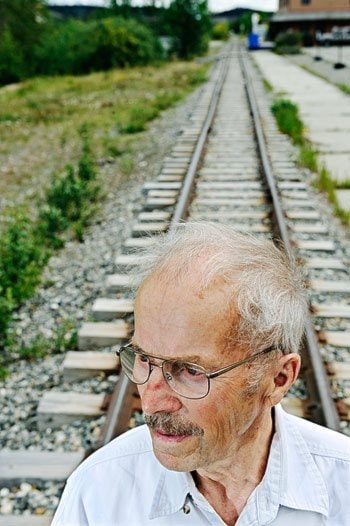In 1962, Paul Cyr proved he was bigger than steam engines.
The snow that winter had piled in billowing dunes at the White Pass summit, northeast of Skagway, where the White Pass and Yukon Route train had to cross to get to Whitehorse, some 178 kilometres away.
The train company sent out their two rotaries - heavy cars with giant blades to sluice through snow - to clear the way.
One of the rotaries got stuck just 24 kilometres outside of Skagway. The next one didn’t get far either.
So they sent Cyr, a man from Whitehorse who was skillful with a Caterpillar D8, to help clear up the rotaries.
To make a path, Cyr had to drive the Cat over one of the railway’s perilous bridges, plowing snow all the while.
“If you made a mistake, you didn’t make it,” says Cyr, who is now 87.
He remembers there were no lights on the bridge. A kid with a flashlight was telling him where to go.
“I hadn’t been across any of the bridges yet,” he said. “And these were some big bridges.”
With the Cat’s plowing blade down, Cyr couldn’t see the rails beneath him.
Holding the Cat at the centre of the narrow gauge rails, he eventually got across. He then helped clear up the rotaries within half and hour and they were back on their way.
His act of bravery proved that Cats could be used on the railroad when the big engines couldn’t. He ended up saving the company a lot of money, he said.
Two of the railroad bosses hugged him at the end of the ordeal, and immediately went and bought a new Cat with heating, a radio and more comfortable bench. Cyr would continue to work the next 20 years of his life on the White Pass route.
On June 1, Cyr was rewarded for his daring with the Pioneer of the Year Award. The honour, bestowed at a ceremony at the Transportation Museum last week, puts him alongside other famous Yukoners in the Transportation Hall of Fame.
It’s a fitting distinction. Cyr, who now lives in Tagish with his wife Alice, helped build the Yukon when trains and steamboats were its lifelines.
His dad, Tony, came to the Yukon from Montreal with his brother Mike in 1889, crossing by the Chilkoot Pass.
“They were on their way to Dawson but when they got here it was the end of the road,” said Cyr, sitting on a bench beside the now-defunct railroad tracks in Whitehorse.
Tony started a family business hauling supplies around the rapids. Born in 1923, Cyr would earn his skills on a Cat while working for the company.
“I couldn’t reach the pedals (on the Cat,)” he said. “So (my brother) had to make blocks so I could reach.”
The Cyrs use to haul wood from across the river. They had two sleighs pulled by the Cat, and each sleigh would carry four cords.
Cyr was the driver while others did the bull work of loading the wood. But it didn’t mean he was out of danger.
One time, while bringing wood down a hill, Cyr lost control of the Cat. He bailed and the cords came tumbling down right where he had been sitting.
“Jesus Christ, it was like, ‘How are we going to tell that to dad?’” said Cyr.
The Cyrs also carried water into Whitehorse from the Yukon River. It cost five cents a bucket.
“Nobody had running water,” he said.
In his teenage years, before the Second World War, he worked as a waiter on the steamboat Casca 2.
“There was hardly any money in it, but if you got tipped by the right ones, you had an extra little money,” he said.
The steamboats were still busy back then even if the Gold Rush was long gone, he said.
Still in his teens, he remembers seeing the White Pass come in with giant blocks of ice cut from colder regions near the White Pass summit.
The blocks were stored in an ice house near Schwatka Lake. They were then cut and used as refrigeration on the steamboats.
After a brief stint trying to get an aircraft mechanic licence in Anchorage, Cyr visited Whitehorse to see his mother.
“I went out to Taylor and Drury’s store just up the street here and I see the lights flashing and the horn and say, ‘Who the devil’s that?’”
It was three of the White Pass and Yukon Route’s top bosses. They offered Cyr a job to replace an engineer.
“(The engineer) was quite the sauce drinker,” said Cyr. “They were going to replace him and they didn’t know with who.”
The bosses told him that once he put his hands on the doorknob of the White Pass building, he was on the payroll.
So he headed back to Anchorage, grabbed his 56 Buick, and drove back to Whitehorse.
He was eventually put up in Skagway where he spent most of his life working for the White Pass and Yukon Route company.
And while he speaks fondly of the new fancier Cat his bosses bought him, he speaks fondly of the first machine that helped him break through the snow.
“It was an oldtimer, but boy it was strong.”
Contact James Munson at
jamesm@yukon-news.com.
